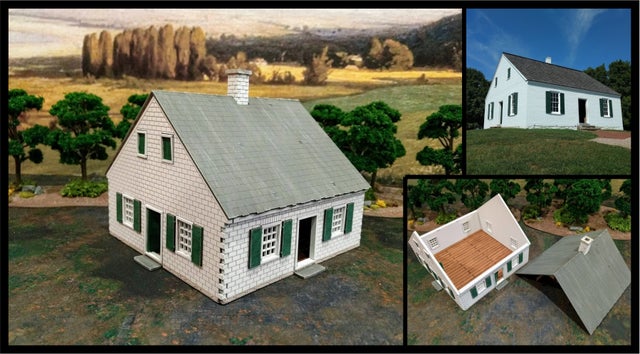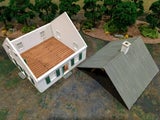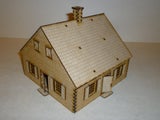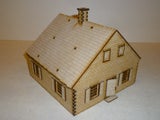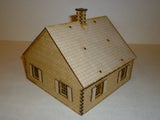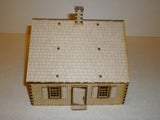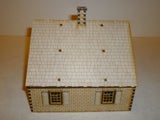- Store
- >
- Laser-cut Kits
- >
- Historic American Buildings
- >
- Dunker Church - Antietam
Dunker Church - Antietam
SKU:
HAB-19
$28.50
$28.50
Unavailable
per item
Detailed building kit for 28mm figures (1:56 scale)
Laser cut 3mm and 1.6mm HDF
Laser engraved details
Moveable doors
Removable roof
Easily accessible interior with detailing
Kit supplied unassembled and unpainted
Measures approx. L 6” x W” x H 5-1/4” / 150mm x 150mm x 130mm
Detailed instructions are available for download at www.thingsfromthebasement.com
The Battle of Antietam, fought September 17, 1862, was one of the bloodiest battles in the history of this nation. Yet, one of the most noted landmarks on this great field of combat is a house of worship associated with peace and love. Indeed, the Dunker Church ranks as perhaps one of the most famous churches in American military history. This historic structure began as a humble country house of worship constructed by local Dunker farmers in 1852. It was Mr. Samuel Mumma, owner of the nearby farm that bears his name, who donated land in 1851 for the Dunkers to build their church. During its early history the congregation consisted of about half a dozen-farm families from the local area.
During The Battle
On the eve of the Battle of Antietam, the members of the Dunker congregation, as well as their neighbors in the surrounding community, received a portent of things to come. That Sunday, September 14, 1862, the sound of cannons booming at the Battle of South Mountain seven miles to the east was plainly heard as the Dunkers attended church. By September 16 Confederate infantry and artillery was being positioned around the church in anticipation of the battle that was fought the next day.
During the battle of Antietam the church was the focal point of a number of Union attacks against the Confederate left flank. Most after action reports by commanders of both sides, including Union General Hooker and Confederate Stonewall Jackson, make references to the church.
At battles end the Confederates used the church as a temporary medical aid station. A sketch by well known Civil War artist Alfred Waud depicts a truce between the opposing sides being held in front of the church on September 18, in order to exchange wounded and bury the dead. At least one account states that after the battle the Union Army used the Dunker Church as an embalming station. One tradition persists that Lincoln may have visited the site during his visit to the Army of the Potomac in October 1862.
As for the old church, it was heavily battle scarred with hundreds of marks from bullets in its white washed walls. Likewise artillery had rendered serious damage to the roof and walls. By 1864 the Church was repaired, rededicated and regular services were held there until the turn of the century.
Source: nps.gov
During The Battle
On the eve of the Battle of Antietam, the members of the Dunker congregation, as well as their neighbors in the surrounding community, received a portent of things to come. That Sunday, September 14, 1862, the sound of cannons booming at the Battle of South Mountain seven miles to the east was plainly heard as the Dunkers attended church. By September 16 Confederate infantry and artillery was being positioned around the church in anticipation of the battle that was fought the next day.
During the battle of Antietam the church was the focal point of a number of Union attacks against the Confederate left flank. Most after action reports by commanders of both sides, including Union General Hooker and Confederate Stonewall Jackson, make references to the church.
At battles end the Confederates used the church as a temporary medical aid station. A sketch by well known Civil War artist Alfred Waud depicts a truce between the opposing sides being held in front of the church on September 18, in order to exchange wounded and bury the dead. At least one account states that after the battle the Union Army used the Dunker Church as an embalming station. One tradition persists that Lincoln may have visited the site during his visit to the Army of the Potomac in October 1862.
As for the old church, it was heavily battle scarred with hundreds of marks from bullets in its white washed walls. Likewise artillery had rendered serious damage to the roof and walls. By 1864 the Church was repaired, rededicated and regular services were held there until the turn of the century.
Source: nps.gov

